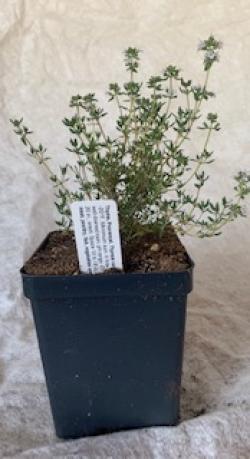Your search for Thyme returned 18 items.
Displaying items 1 thru 15
Thyme, Minor.
Thymus praecox subsp. britannicus 'Minor'. (Minus) Perennial, hardy to below 0°F. Sometimes called ‘Minus’. Dwarf, slow growing. Height to 4 inches.Thyme.
Thymus 'Wedgewood English'. This is much the same as flat-leafed English thyme, except for a small, light-colored mark on each leaf that looks like a Wedgewood china pattern, increasing its ornamental value. This variety is a discovery of Cyrus Hyde at Well-Sweep Herb Farm in New Jersey. Space 18 to 24 inches.Thyme, English.
Thymus 'Broad-leaf English'. Thanks to the ground breaking work of Harriet Flannery Phillips, we know a lot more about thyme than we did before she completed her study of the genus Thymus in 1982. What we called English Thyme may have been one of the biggest surprises: it is unable to reproduce itself from seed because it is a single sex, (female) and seedling offspring would have to be hybrids. This is the true English thyme which makes those soft, round 12-inch high mounds. It is softly aromatic and winter hardy with delicate spring blooms. It can be reproduced only from cuttings. An easy way to distinguish English thyme is to look at the leaves. The leaf-margins of this thyme are flat, without the slightest curl.Thyme, Golden Lemon.
Thymus x citriodorus 'Aureus'. A variegated form of lemon thyme with golden-edged leaves, it is colorful and surprisingly fragrant of lemons. The variegation is less pronounced during the hot, sunny days of summer. Space on 18 to 24-inch centers.Thyme, Green Lemon.
Thymus x citriodorus. This rapidly growing thyme has deep green leaves imbued with a sweet lemony fragrance. Rubbing a chicken's skin with lemon thyme turns a simple roasted bird into a gourmet treat. Semi-upright plants are about 12 inches tall.Thyme, Lavender.
Thymus 'Pinewood'. Perennial, though not reliably hardy in this area. Probably the same plant as the hybrid Thymus 'Pinewood'. The common name refers to the unusual purple flower color, not to any similarity in aroma to its namesake. This semi-upright/ trailing variety forms a beautiful dense green mat. Makes good low border plant. Height to 4-6 inches. Edible but better suited as an ornamental variety.Thyme, Silver.
Thymus 'Argenteus'. The leaves of this thyme have a unique silver glow created by gray-green leaves edged with silver, a wonderful contrast with the traditional green leaves in the thyme bed. It forms an aromatic mound. A border edged with this thyme will prove eye-catching.Thyme.
Thymus vulgaris 'Narrow-Leaf French'. (German Winter, Common, Garden). We have often grown this variety from seed, but notice from time to time differences in aroma and leaf shape. We selected a plant with aroma and upright stature and now propagate it from cuttings to assure uniformity. The plant has medium-sized leaves and an aroma without harshness. Small lilac blossoms appear in spring. Grows 12 to 16 inches tall.Thyme.
Thymus vulgaris 'Orange Balsam'. The narrow, sharply pointed dark green leaves pack a wallop with an intense aroma of balsam and oranges. Plants are dense, about 12 inches high and 15 inches wide. Plant on 12 to 15 inch centers.Thyme.
Thymus vulgaris 'Provencal'. This variety was selected from seedlings of common thyme by Thomas DeBaggio for its strong aroma. It has a woody, upright growth habit, becoming somewhat gnarled after several years. Leaves are tiny, gray-green arrowheads, held throughout the year. Mature plants are 12 to 16 inches tall and may spread to 24 to 36 inches if left unpruned. Excellent culinary variety.Thyme.
Thymus 'Archer's Gold'. Only 2 1/2 inches tall, this vigorous dense creeper has lovely green-gold leaves that will leave you breathless as they tumble over the edge of a hanging basket. Excellent between pavers on a walkway. Winter hardy.Thyme.
Thymus 'Doone Valley'. Perennial, hardy to 0°F, although the central crown may experience some winter-kill. A mounding, prostrate variety with golden variegation appearing in the early spring and fall, disappearing in mid-summer. Lemon scented, with rose-pink flowers.Thyme.
Thymus praecox subsp. arcticus 'Elfin'. Perennial, hardy to about 0°F. Lovely creeping habit forming a tight mound. Magenta flowers. Height 2 to 3 inches. Good groundcover for a sunny, well drained area between stepping stones. Will take light foot traffic. Edible but better suited as an ornamental.Thyme, Creeping.
Thymus pulegioides. With its medium-size, bright green leaves and colorful pink flowers, this vigorous procumbent thyme will charm the bees and your heart. For several years we had a one of these growing in the gravel by the cash register in Arlington. It wandered there, tamed by the many feet that brushed it, for many years until a child pulled it, thinking it was a weed.Last Seed Source: www.johnnyseeds.com

